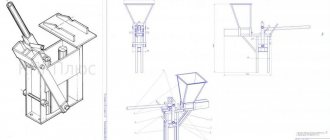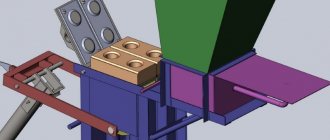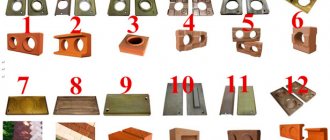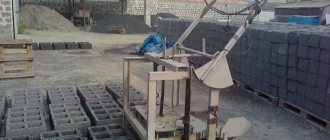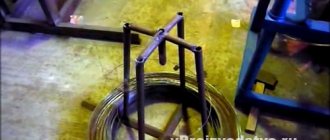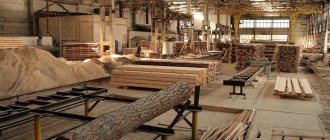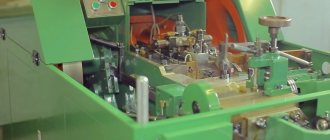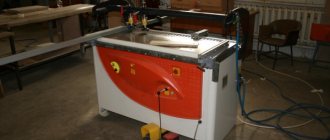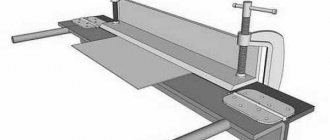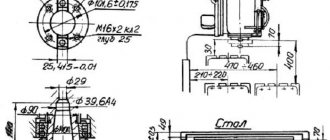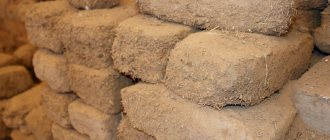Types of machines for Lego bricks and selection criteria
The Lego machine can have a manual, hydraulic or electric drive. Manual machines are cheaper, but can only handle a limited output. In addition, the quality of their products is somewhat lower than that of electrified ones.
Based on productivity, machines are divided into three types:
- Small. Around 1000 bricks in a standard eight hour shift. Available with manual and electrified drives, they cost from 80 to 200 thousand rubles.
- Average. 2-3 thousand bricks per shift, electrified, cost from 200 thousand rubles.
- Industrial. Up to 800 bricks per hour, cost from 2,000 thousand rubles.
Hydraulic Lego machine
The hydraulically driven machine, designed for small production volumes, is quite compact. Its dimensions:
- height: 2 m;
- width and length - 1.5 m each;
- weight - up to a ton.
A space of 10 m2 is enough for operation.
Operating principle
The method of operation of the Lego brick machine is simple.
The prepared working mixture should be poured into the hopper. A dispenser supplies the required amount of it into the molding matrix. Then the mixture is compressed using a lever.
The manual drive allows you to achieve a force of up to 2 tons, hydraulic - 5-12 tons.
After the end of the lever stroke, several (depending on the capacity of the matrix - from 3 to 15) ready-made Lego bricks are obtained in the working compartment. Next, open the working compartment and remove the molded Legos. The manual drive is driven by the operator’s muscular strength; the pressure in the hydraulic system is pumped up by a hydraulic pump driven by an electric motor.
Specifications
The main indicators by which different machine models are compared when choosing are given below:
- Resource. Expressed in the guaranteed number of operating cycles. For manual machines, the figure must be at least 500,000. For models with electric drives - from 1,000,000.
- Operating pressure. The higher the indicator, the stronger the product. Lego bricks, formed on manual machines with a force of 2 tons, are best used for the construction of one-story sheds and for decoration. Bricks compacted with a force of 20 tons are suitable for load-bearing walls.
- Production rate. Expressed in the time it takes to produce one Lego. Usually from 10 to 40 seconds. Depends on the number of cells in the matrix.
In addition to the indicated indicators, the Lego machine is characterized by operating modes.
Reviews from builders about Lego bricks
Victor Anatolyevich: It’s always difficult to delve into something new. All my life I have been laying ordinary bricks and did not even think about any know-how or new technologies. And then one day I came across an advertisement in the newspaper about the mass sale of so-called Lego bricks. Well, while I was on vacation, I decided to ask what kind of bricks these were and what they were needed for. It turned out to be a very ordinary block with two convex holes that can be placed one on top of the other. I took a dozen of these blocks as a test and began to practice laying them at home. It turned out that you can lay out a pillar in your dacha using them very simply and quickly. In addition, little glue and concrete are needed to use. The downside is the cost. They are several times more expensive than ordinary bricks.
Andrey: I live in a village and do construction and repairs. In rural areas, people engaged in such crafts are not in short supply, but I am known as a respected and decent professional. I can carry out work of almost any complexity and with different materials. An order was received from a respected and wealthy person within the framework of the village to build a house for guests. And so that the latest technologies are used and the quality is excellent in all respects. In the villages it is quite difficult to get really decent materials; basically everyone uses the old-fashioned way. I went to the city, bought almost everything I had planned, but instead of the usual brick or block, I ordered a Lego brick, which was actively advertised there. Laying such bricks requires less time, glue, concrete and reinforcement, which can simply be inserted into the trenches formed by the holes in the brick. The work with the crew was completed ahead of schedule, and they even allowed themselves to rest more than necessary. The owner was pleased. I think I will continue to use it in my work in the future.
Sergey: Sometimes I feel like a shoemaker without boots. He himself is a builder and has done few buildings with his own hands on a summer cottage. I decided to somehow update the fence. I planned to make concrete pillars, as I did before. But then I came up with the idea of using Lego bricks that had long attracted my attention on the Internet. I went and saw what they were like. I bought it and brought it to the dacha. I must say that they are somewhat more expensive. But they can be installed quickly and without using glue. And this is a definite plus. In just a couple of hours I laid out all the pillars that were needed! And this is with a small amount of concrete and reinforcement. True, while I was laying it out, I realized that such a brick would be perfect for laying pillars, but would be difficult to build the walls of a house. Why? Yes, it’s simply impossible to divide them, if necessary, into half or one third. And before buying them, you need to accurately calculate the foundation, length and width of the house for such masonry. And this thing is very convenient.
Operating modes
Lego brick machines can operate in manual and semi-automatic mode. In the first, the operator performs all operations – loading the mixture into the hopper, feeding it into the working chamber and increasing the force to the required value – independently.
In semi-automatic mode, all he has to do is load the mixture and take out the finished product - the device will do the rest itself. This mode increases productivity by one and a half to two times and significantly increases the stability of the strength characteristics of the product.
Industrial machines also implement an automatic mode, in which all operations occur without the participation of an operator, but under his supervision.
Industrial equipment for the production of Lego bricks
The machine can operate in manual and semi-automatic modes.
Lego brick - weight
It is necessary to talk about the weight of a brick based on knowledge of its composition and processing conditions. On average, we can talk about a weight of 3-3.5 kg. This makes it possible to achieve the strength characteristics of M150, which makes it possible to use Lego bricks in the construction of partitions and load-bearing walls of house construction. Average frost resistance makes it possible to use raw materials for 35-40 cycles of temperature changes. When stored, there are about 500 bricks per cubic meter, the density of which is approximately 1.55 tons per cubic meter. Adjusting the recipe leads to a change in the technical characteristics of the brick.
Consumables and tools
The high performance of the final product of the Lego machine is largely determined by the correct selection of the components of the working mixture.
It includes:
- cement grade 300-400, from 5 to 15%;
- filler - screening fractions of crushed stone - 80-90%;
- water;
- pigment to give a specific color.
You will also need tools and auxiliary equipment for Lego production:
- concrete mixer;
- containers for mixture components;
- vibration compactor;
- loading and unloading equipment;
- transport.
Lego brick - mixture composition
To make a Lego brick, you need to understand that the share of filler in the mixture reaches 80-92% of its total mass. For this role, screenings from crushed limestone are most often selected. For the binding part, cement or Portland cement is used, the mass fraction of which is set at 8-10%. In addition, pigmenting elements will be required that will allow you to change the color of the brick. As a rule, products are produced in black, yellow, brown, and red.
Tip : It is worth noting that there are no ideal recipes for Lego bricks, however, in the instructions for the machine you can find several recipes that are recommended by the manufacturer specifically for a specific model of the machine.
The use of plasticizers is not mandatory, however, Lego bricks that are made using it are characterized by higher density and strength. In addition, the structure becomes more uniform and the surface smoother.
Advantages and disadvantages of Lego bricks
Compared to fired ceramic bricks, Lego has the following advantages:
- perfect shape, not distorted by firing;
- low moisture absorption;
- environmentally friendly production;
- simplicity of technology and low energy consumption;
- frost resistance;
- the ability to conduct communications through holes in Lego.
Application of Lego bricks
Lego brick has its own disadvantages:
- little experience in operating buildings does not allow us to accurately estimate the service life of the material;
- The lack of standards and mention of the material in SNiPs delays its widespread use in the construction market.
Cost of Lego bricks
To calculate the cost of one Lego brick, you need to calculate the costs of equipment, reducing them to a unit of manufactured products, based on the passport values for the number of cycles of use without repair. In addition, take into account the costs of raw materials and electricity, as well as wages of hired workers and the profit of the entrepreneur.
Based on practice and reviews from machine owners, the cost is about 4-6 rubles per brick. At the same time, the market often offers to purchase the corresponding products for 11-12 rubles. With such a retail markup, the payback for the equipment is about 1 year. To expand the range, you can purchase a machine for making self-tapping screws. Many builders perform complex work, including finishing work in the project package. Considering that not everyone trusts the new technology, it is possible to simultaneously create the production of foam blocks at home. Thus, it will be possible to reach a wider audience and increase the number of buyers.
DIY machine
There are many general diagrams and detailed drawings of machines for producing Lego bricks on network resources.
To make a simple DIY brick machine you will need:
- steel sheet 2-3 mm;
- channel 10 cm, thickness 4-5 mm;
- 89 mm pipe for the piston;
- 50 mm pipe for lever;
- fasteners;
- primer and paint.
Equipment you will need:
- welding inverter;
- Angle Grinder;
- abrasive paper.
General view drawing of a machine for Lego bricks
Assembling a machine for producing Lego bricks with your own hands is quite possible for a home craftsman with experience in welding and metalworking operations.
Product range
Before starting production, it is worth deciding on the type of product. Using special machines and dies, you can produce the following types of Lego bricks:
- Standard. The most popular option, because most of the equipment on the market involves the production of such products. Even if there is no money to purchase other matrices, the classic look of Lego bricks should be on sale.
- Rail-shaped. This type of building material is in demand among professional builders. The main feature is the stacking of blocks according to the rail principle. If you want to enter a large market, purchasing this matrix is mandatory. Its cost is in the range of 25-50 thousand rubles.
- Simple. Lego bricks are produced piece by piece. For beginning entrepreneurs, this option is considered the most affordable.
- Original. The peculiarity of the matrix is that it is manufactured to individual sizes. Such “templates” are purchased to fulfill specific orders.
- Combined. The main difference of the matrix is the ability to simultaneously produce two or three blocks.
- Fitting. Lego bricks are combined not only at the top and bottom, but also at the sides.
Sequence of work
Carefully studying the machine drawing before cutting the material will help save time on correcting errors. The sequence of manufacturing operations is as follows:
- Cut two meter racks from the channel.
- Connect them with crossbars into a frame.
- Weld the chassis for the bunker on top. On the one hand, it is necessary to provide a limiter. Make a hole along the diameter of the piston.
- Cut the steel sheet and weld the parts into a bunker. Its dimensions correspond to the dimensions of the working chamber. The hopper must move along the upper channel.
- The piston is assembled from a sheet rectangle and reinforced with stiffeners.
- Weld a handle for opening/closing to the hopper lid.
All that remains is to clean, prime and paint the machine.
Technological production process
The Lego production technology is based on the super-compression operation. Under high pressure, the material is compacted, and its particles are sintered together without heating.
The technological process is divided into the following stages:
- The thoroughly mixed working mixture is poured into the hopper.
- The dispenser measures the volume of mixture required for one working cycle.
- This volume enters the matrix, where the Lego is molded under pressure.
- Molded bricks are stored on pallets and dried under natural conditions for 2-3 weeks. At this time, the mixture finally hardens and gains strength.
Drying times may vary depending on the ingredients used. It must be selected in accordance with the user manual.
Lego brick production technology
The Lego brick production technology includes several stages. The dry mixture is supplied to a special bunker. Using a dispenser, a strictly established volume of the mixture is sent to a special chamber, which will become the basis for a new brick. A matrix is installed in the chamber, on which the number of bricks created after pressure treatment depends. In general, the design may vary depending on the manufacturer.
During high pressure treatment, the mixture is “sintered” with water and cement. This method is called “cold welding”. After opening the press, the platform with the products installed on it moves up. The worker gets the opportunity to use the finished brick, as well as place it directly on a pallet to ensure further steaming or drying. The resulting Lego brick must be left in a warehouse for several days so that it gains strength. The drying time depends on the type of machine, the composition of the mixture, and the dimensions of the product.
Additionally, to organize a high-performance mini-factory, you will need a mixer to reduce the cost of producing Lego bricks. When purchasing a ready-made mixture, the consumables are significantly higher than when making it yourself. The mixer must have durable blades, and their number must be at least 4. In addition, you will need a transport tape, through which the mixture will be delivered to the bunker. At the initial stage, you can reduce costs by loading manually, but this will require quite a lot of labor.
Tip : Most machines require a small number of operating personnel. In many cases, just one person can handle the entire job. To increase productivity, you will need to attract two or three workers. One can be put to work with the machine, the rest to control the supply of the mixture, filling the hopper, etc.
It’s worth getting pallets in advance for placing lots of Lego bricks. To fill the raw materials, you will need shovels that are resistant to abrasives. When the coating wears off and particles get into the mixer, a technological problem may arise, due to which defects will appear in the Lego brick caused by changes in the chemical composition. Special brushes are useful for cleaning equipment between production cycles.
Additional components
To make work easier and provide additional opportunities, manufacturers offer a wide selection of components:
- Press forms. Allows you to obtain Lego elements of non-standard sizes and shapes.
- Feeding belt devices for loading the mixture into the hopper. Useful for large production volumes.
- Specialized mixer. Designed taking into account the parameters of the mixture and ensures greater homogeneity compared to general purpose concrete mixers.
- Sets of pigments for obtaining various shades of products.
Shovels, measuring buckets and other containers and tools are also available.
